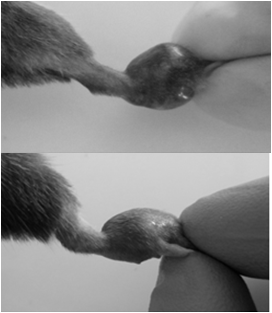Effectiveness of the Petiveria alliacea (mapurite) plant infusion on the evolution of the malignant melanoma in C57BL/6 mice
Keywords:
P. alliacea, mice C57BL/6, melanotic cells, cancer, mapuriteAbstract
The present work is defined as a descriptive study supported by non experimental field research, whose With the aim to determine the effectiveness of the P. alliacea (mapurite) plant infusion on the evolution of malignant melanoma in C57BL/6 mice, 64 mice were distributed in three groups: Control Melanoma, Preventive Treatment and Curative Treatment. 100,000 melanocytic cells were inoculated subcutaneous in the paw pad. Mapurite infusion was prepared at 1% and administered ad libitum, starting 15 days prior to inoculation in the Preventive and at the moment of inoculation in the curative group. Results shown that females survival was significantly higher in the groups treated with P. alliacea. In males no statistically significant differences were observed for mean survival time, however, 20% of the Preventive group survived more than 60 days. In terms of weight, statistically significant differences between groups were obtained in males, where 100% of those in the Control group, 64% in the Preventive group and 55% in the Curative group lost weight. In both females and males, the tumor increased significantly, however, in the male Preventive group, tumors were smaller at the third and fourth weeks, with a statistically tendency to significance. In conclusion, P. alliacea infusion increased survival and decreased lost weight and tumor growth, which suggest that mapurite could be used as an adjuvant in the treatment of malignant melanoma.
Downloads
References
[2] Organización Mundial de la Salud. 10 datos sobre el cáncer. Disponible en: URL: http://www.who.int/features/factfiles/cancer/es/
[3] Capote L. Aspectos epidemiológicos del cáncer en Venezuela. Rev Venez Oncolog 2006; 18:269-281.
[4] González N, Flores A. El melanoma en México. Rev Espec Méd-Quir 2010; 15:161-164.
[5] Morillo D, González B, Sulbarán A, Ibarra A, Álvarez C, Colmenares M, Bonfante R. et al. La infección por Trypanosoma cruzi disminuye el desarrollo del melanoma maligno e incrementa la supervivencia en ratones C57BL/6. Invest Clin 2014; 55:227-237.
[6] Sociedad Americana de Cáncer. Tipos de tratamiento. Disponible en: URL: https://www.cancer.gov/espanol/cancer/tratamiento/tipos
[7] Organización Mundial de la Salud. Nuevas directrices para fomentar el uso adecuado de las medicinas tradicionales. Disponible en: URL: https:http://www.who.int/mediacentre/news/releases/2004/pr44/es/
[8] Fabricant D. The value of plants used in traditional medicine for drug discovery, Envirom Health Perspect, 2001; 109:69-75
[9] De la Guardia Peña O, Castillo A. La tableta de anamú: un medicamento herbario inmunoestimulante. MEDISAN, 2004; 8:57-64.
[10] Ferrer J. Principales referencias etnomédicas sobre el anamú (Petiveria alliacea linn) y principios activos encontrados en la planta. Un acercamiento al tema. Rev CENIC. Cs biol, 2007; 38:27-30.
[11] Sociedad Americana de Cáncer. ¿Cuáles son los factores de riesgo del cáncer de piel tipo melanoma? Disponible en: URL: https://www.cancer.org/es/cancer/cancer-de-piel-tipo-melanoma/causas-riesgos-prevencion/factores-de-riesgo.html
[12] Swetter S, Clarke C, Keegan T. The melanoma letter summer. Skin Cancer Found, 2004; 32:2 articles.
[13] Markowitz J, Cosimi L, Carey R, Kang S, Padyk C, Sober A, Cosimi A.et al. Prognosis after initial recurrence of cutaneous melanoma. Arch Surg, 1991; 126:703-707.
[14] Marzagalli M, Casati L, Moretti R, Montagnani M, Limonta P. Estrogen receptor β agonists differentially affect the growth of human melanoma cell lines. Plos One, 2015; 10:e0134396.
[15] Kanter L, Girnita L, Girnita A, Dricu A, Olsson G, Leech L, et al. Tamoxifen-induced cell death in malignant melanoma cells: possible involvement of the insulin-like growth factor-1 (IGF-1) pathway. Mol Cell Endocrinol, 2000; 165:131-137
[16] Matsuoka H, Tsubaki M, Yamazoe Y, Ogaki M, Satou T, Itoh T, et al. Tamoxifen inhibits tumor cell invasion and metastasis in mouse melanoma through suppression of PKC/MEK/ERK and PKC/PI3K/Akt pathways. Exp Cell Res, 2009; 315:2022-2032.
[17] Lowe H, Facey C, Toyang N, Bryant L. Specific RSK kinase inhibition by dibenzyl trisulfide and implication for therapeutic treatment of cancer. Anticancer Res, 2014; 34:1637-1641.
[18] Williams L, Rosner H, Levy G, Barton N. A critical review of the therapeutic potential of dibenzyl trisulphide isolated from Petiveria alliacea L (guinea hen weed, anamu). West Ind Med J, 2007; 56:17-21.
[19] Murray J, Picking D, Lamm A, McKenzie J, Hartley S, Watson C, et al. Significant inhibitory impact of dibenzyl trisulfide and extracts of Petiveria alliacea on the activities of major drug-metabolizing enzymes in vitro: An assessment of the potential for medicinal plant-drug interactions. Fitoterapia, 111; 2016:138-146.
[20] Williams LA, The TL, Gardner M. T, Fletcher C. K, Naravane A, Gibbs N, Fleishacker R. Immunomodulatory activities of Petiveria alliacea. Phytother Res, 1997; 11:251-253.
[21] Quadros M, Souza A, Queiroz M. Petiveria alliacea L. extract protects mice against Listeria monocytogenes infection-effects on bone marrow progenitor cells. Immunopharmacol Immunotox 1999; 21:109-24
[22] Queiroz M, Quadros M, Santos L. Cytokine profile and natural killer cell activity in listeria monocytogenes infected mice treated orally with Petiveria alliacea extract. Immunopharmacol Immunotox 2000; 22:501-518.

Published
How to Cite
Issue
Section
Gaceta de Ciencias Veterinarias se apega al modelo Open Access, por ello no se exige suscripción, registro o tarifa de acceso a los usuarios o instituciones. Los usuarios pueden leer, descargar, copiar, distribuir, imprimir y compartir los textos completos inmediatamente después de publicados, se exige no hacer uso comercial de las publicaciones. Para la reproducción parcial o total de los trabajos o contenidos publicados, se exige reconocer los derechos intelectuales de los autores y además, hacer referencia a esta revista. La publicación de artículos se hace sin cargo para los autores. Los trabajos pueden consultarse y descargarse libremente, y de manera gratuita, en extenso en versión digital, desde su enlace Web institucional. Los textos publicados son propiedad intelectual de sus autores. Las ideas, opiniones y conceptos expuestos en los trabajos publicados en la revista representan la opinión de sus autores, por lo tanto, son estos los responsables exclusivos de los mismos.


